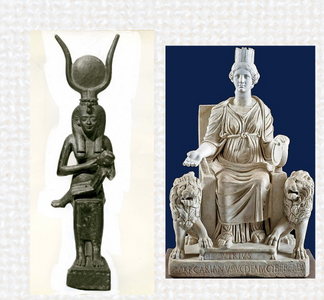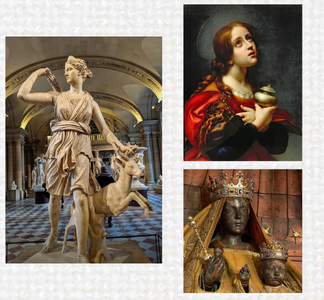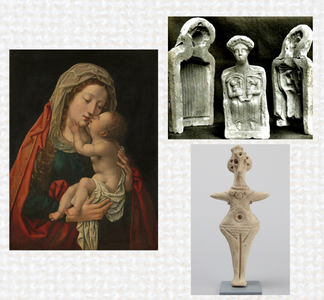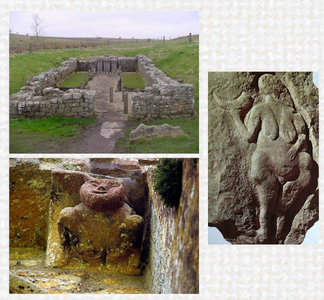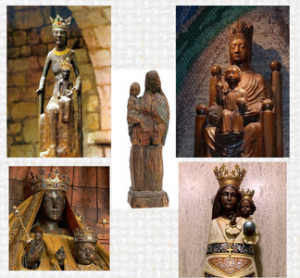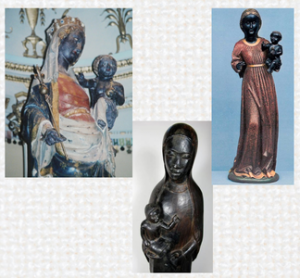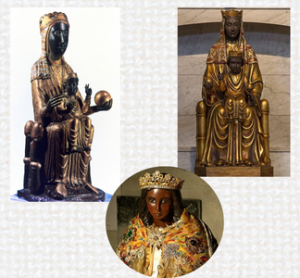If you have been awakened to a whisper that ‘I am Mary’ and ‘I have a story’ the chances are that you have been stirred to her calling. But who is she?
The Black Madonna has many presentations throughout history: Mary Magdalene, the Divine Mother, Isis, Cybele, Astarte, Artemis, Mother Mary, and a great many other ancient goddesses far too many to name here.
She holds a place in history and in folklore. Her writings existed for all to recite, hundreds of prayers and writings which legend says were in her own words. She also wrote her own gospels. There were many more dedicated prayers written to her.
An example is this Marion cult prayer worshipping the Virgin Mother Mary, and later adopted by the Christian Churches:
Hail Mary
Hail Mary,
Full of Grace,
The Lord is with thee.
Blessed art thou among women,
and blessed is the fruit
of thy womb, Jesus.
Holy Mary,
Mother of God,
pray for us sinners now,
and at the hour of our death.
Amen.
Most of the Black Madonnas in churches sit and have the Jesus child on her lap, showing us that this is the representation of the mother of Jesus, and that might be so. Yet, this is not the full presentation of what the Divine Feminine seeks to reflect to us all in the Black Madonna. There are a great many other Black Madonnas, who underneath their elaborate gowns have characteristics which are not reflecting the Virgin Mother, rather, other representations of the Divine Feminine prayed to and venerated throughout history. This includes Mary Magdalene presented as the Black Madonna honouring the devotion to her as Jesus’s first disciple as well as her own capacities for knowledge, vision, and insight.
We do know that they sit on sacred sites that the ancient Celts held in secret, prehistoric monuments, sacred rocks and forests, old paths, crypts and buried underground to secure their safety.
If we look at the sculptures that exists today most began in the 11th century with stories of even older sculptures that were buried or hidden. These sculptures need to be viewed from a few points, some argue that they are a vision of the artists expression, the environment of where she is, original materials, skin pigmentation of the model if there was one, the repairs and sometimes full restoration, the type of wood used and when heated the wood went darker. What we need to remember is the early church tried to be rid of these sculptures but to get Christianity off the ground they needed to accept the Black Madonnas and her undeniable miracles that she alone performed. So, they painted them white, put them in ornate garments and jewelled crowns until eventually they became someone else (a reflection of only the Virgin Mother) and then she was relegated into a side chapel or crypt to play down her importance.
Why is she called Black and is sometimes black in colour?
The language which Jesus was preaching was Aramaic and in ancient Aramaic, black means ‘sorrowful’. To this day we wear black when grieving.
It is a language that is used in a turn of phrase, meaning a manner of words to use as expression. The Blessed Mother (loss of her son) is linked to Isis (loss of her husband) both who are called ‘sorrowing’ in their search. Were they both black? Possibly, and they were both in sorrow.
The catholic church’s explanation for the Black Madonnas are that her image was darkened by smoke from candles or by fires, unlikely, but some evidence does suggest that the walls where the Madonnas were placed were covered sometimes in soot. There are the eternal flames (the eternal lamp) ever present that burn for her Divine Presence put there by worshippers and by Kings and Queens of the day.
Also, during wars such as the Muslim wars, wars on religion, French revolution, Napoleon’s occupations, and Spanish civil wars, she was buried in the earth and hidden often for centuries. The local worshippers hid their Madonnas underground passing on the secret from generation to generation as to where she was. It is possible that the chemicals in the soil reacted with the wood and changed her from white to black.
Also, a lot of these Black Madonna statues came out of the holy lands where they were carved, looking very Byzantine in style as the characteristics of the day would have been.
The messages and blessings of the Black Madonna remain the same today as in history. She receives our prayers and guides us to her heart. Her miracles recounted throughout history are to remind us of her Presence for all and to continue to know she is here for us.
Notre Dame du Monde
The calling received from Notre Dame of Rocamadour in 2019 to create a Black Madonna in Australia reflects her Divine purpose for those of the modern time. She has not changed; she represents the Divine Feminine. She comes for the relief of all.
While Notre Dame du Monte is not physically created black, she represents the truth of the Black Madonna. She was called to come to be from a Black Madonna. Her image is as she intended.
Rosslyn Blundell
